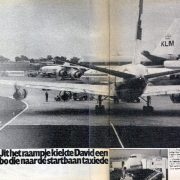It was 1977 when David and 395 passengers aboard a Pan Am flight were headed for a two-week cruise on the Golden Odyssey, a ship destined for several locations including Athens, Greece. But they never made it off the runway. Considered the worst aviation disaster in history, David is a survivor of the plane crash at Tenerife, Canary Islands, where two of the biggest jetliners in the world ran into each other on the ground, killing over 500 people. Only 29 years old at the time, David remembers the events like it was yesterday. Nearly 40 years later, he’s still amazed his automatic reflexes led to his survival.
David recalls that when the plane turned left on the runway, everything came to an abrupt, hard stop, shoving him forward with so much force his glasses came off sending the overhead baggage crashing onto him. As he looked forward he saw thick smoke rolling into the plane from first class. His first thought was “I’m going to die” and that’s when his automatic reflexes kicked in. In one motion, he unclipped his seatbelt, stood up onto his seat and climbed out of the plane through a hole.
When he looked right, the front of the plane was enveloped in smoke. The inboard engine was engulfed in flames and he saw a woman sliding down the wing towards the fire with arms up, calling for help. David grabbed her by the wrists, pulled her up and helped her off the edge of the wing to safety. Standing on the edge of the plane, he jumped nearly 20 feet to the tarmac, and then in a rare moment of clarity realized he had his camera around his neck and took five pictures of the fiery disaster in front of him.
When he hit the ground, the first thing he heard was the Pan Am first officer yelling “run, run, run”. David did just that. Running as fast as his legs could take him, he recalls seeing a fireball rise 50 feet in the air before it hit the fuselage. Later, returning home via plane, he felt indestructible and didn’t experience any post traumatic stress. But 6-7 months afterwards when he decided to fly again, he had a “white knuckle” ride to San Diego.
Never married, David went on to have a successful career as a microwave technician working for Hewlett Packard and then for JDSU in Sonoma County. In 2012 he decided to write a book about his experience, called Never Wait for the Fire Truck. By sharing his experience, he hopes the aviation industry and other passengers will learn important lessons about safety.

